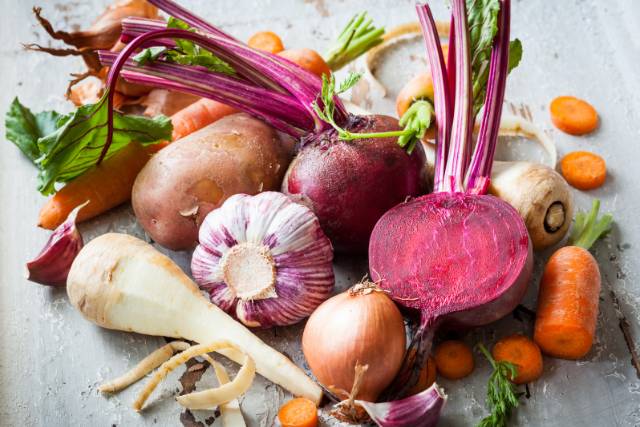Recent Posts
-

- Diabetes-Friendly Nutrition: Smart... 08.12.2024
-

- Nutrition for Chronic... 08.12.2024
-

- Anti-Inflammatory Diet: Food... 08.12.2024
-

- Low-Sodium and Heart-Healthy:... 08.12.2024
-

- Plant-Based Diets for... 08.12.2024
Digging Deeper: The Health Benefits of Root Vegetables

When you enter the underground realm of root vegetables, you will find that the true magic occurs under the grounds. Growing against the grain, these unsung heroes of the vegetable world are the original rebels. They are rising against the grain. With more attitude than your favorite rock band, these underground pleasures are the actual heavyweights of the plant world. They are packed with more attitude than your favorite rock band.
So, get your shovel ready and get ready to uncover the crunchy, colorful, and downright cheeky treasures that are hiding under the surface because when it comes to roots, it's not just about vegetables; it's about a whole delectable lifestyle that's just beneath our feet!
In the case of root vegetables, the edible part of the plant develops underground as a storage organ. Root vegetables are edible plants. These veggies can store the energy and nutrients necessary for the plant to grow and survive.
Some examples of root vegetables that are often used are as follows:
Carrots are orange root vegetables well-known for their sweet flavor and high beta-carotene content.
Potatoes are a versatile root vegetable that may be found in several different types, including sweet potatoes, red potatoes, and russet potatoes.
Sweet potatoes are comparable to potatoes, but they have a distinct sweetness. They are also abundant in vitamins and fiber.
Beets are carrots that may be round or oblong. They taste sweet and earthy and come in various hues, including red, golden, and Chioggia (striped).
Turnips are root vegetables with white flesh and a somewhat peppery taste. They are often used in boiling soups, stews, or roasted meals.
Radishes are spicy little vegetables that are available in a wide range of colors and forms. Radishes are crisp and small.
Parsnips are vegetables that resemble carrots in appearance but have a sweeter and more nut-like taste. They are often used in stews and soups.
Rutabagas are a hybrid vegetable that resembles a mix between a turnip and a cabbage. They have a mild, sweet taste and yellow flesh.
Yams are root vegetables since they are starchy and have a sweet flavor. In certain areas, they are sometimes mistaken for sweet potatoes.
Cassava is a starchy tuber that is often utilized in tropical places. It is well-known for its flexibility and the fact that it does not contain gluten.
Ginger, which is more of a rhizome than a genuine root, is a spice that is both tasty and fragrant, often used in cooking and drinks.
In addition to being an example of an underground bulb, garlic is well-known for its strong taste and culinary applications.
Not only do these veggies have a delicious taste, but they are also abundant in vital elements such as vitamins, minerals, and dietary fiber. They contribute to the varied and nutrient-dense offers that the plant kingdom has, and they are often used as mainstays in a broad range of cuisines all over the globe.
High in Nutrient Content
It is common for root vegetables to have a high concentration of vital vitamins and minerals. The vitamin A content of sweet potatoes is exceptionally high. In contrast, the beta-carotene content of carrots is high, and potatoes' potassium and vitamin C content is high.
Dietary Fiber
Dietary fiber is essential for maintaining digestive health; root vegetables are a good source of this necessary nutrient. Constipation can be avoided, regular bowel movements may be encouraged, and a healthy microbiota in the gut can be established with fiber.
Low in Calories
Many root veggies are low in calories, making them an excellent choice for those attempting to keep their weight reasonably. A further factor that adds to a sensation of fullness is the high fiber content.
Having Antioxidant Capabilities
Certain root vegetables, such as beets, have a high concentration of antioxidants. Antioxidants are beneficial to battle oxidative stress in the body, which has been related to a variety of chronic illnesses as well as the aging process.
Controlling Blood Sugar Levels
Root vegetables include a high amount of fiber, which, when paired with the complex carbs they provide, may help maintain stable blood sugar levels. This may be especially helpful for those who already have diabetes or who are at risk of getting the illness in the future.
Heart Health
Potatoes, and sweet potatoes, in particular, are rich sources of potassium. This mineral is involved in the control of blood pressure. Keeping your blood pressure at a healthy level is very necessary for the health of your heart.
Anti-Inflammatory Effects
Ginger, turmeric, and other root vegetables contain anti-inflammatory chemicals. These compounds may be found in root vegetables. Several disorders are linked to chronic inflammation, and including anti-inflammatory foods in one's diet may be suitable.
Support Immune Function
A high concentration of vitamin A in root vegetables such as sweet potatoes and carrots is essential for maintaining a healthy immune system. In addition, vitamin C, which may be found in potatoes and other root vegetables, is involved in the functioning of the immune system.
Bone Health
Nutrients like manganese and calcium are crucial for keeping strong and healthy bones, and some root vegetables, such as sweet potatoes and turnips, contain these nutrients.
Versatility in Cooking
Root vegetables are versatile, enabling them to be used in various culinary applications. By including a wide range of root vegetables into one's diet, one may guarantee that they incorporate a wide variety of nutrients and tastes.
To make the most of the advantageous effects of root vegetables on one's health, it is necessary to include them in a well-balanced and diverse diet. Because each person's nutritional requirements might differ, it is best to seek the assistance of a qualified dietitian or a healthcare expert to get individualized food recommendations.
Disclaimer: The information provided in this article is for general information purposes only. All information in this article is sourced from other websites, and we do not represent any rights regarding the contents and information on the site. All rights belong to their original owner.





